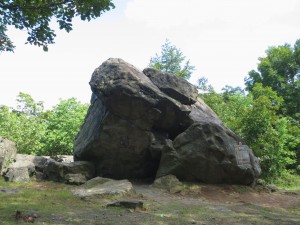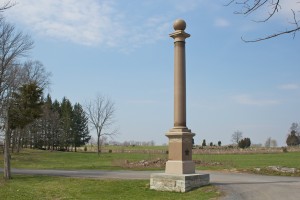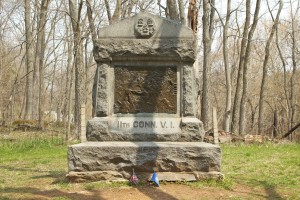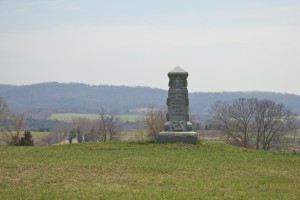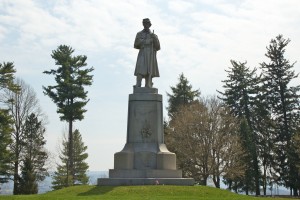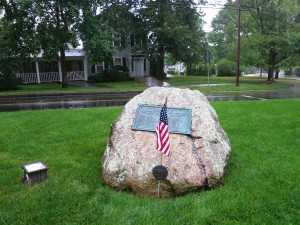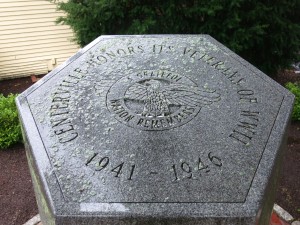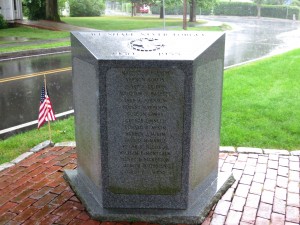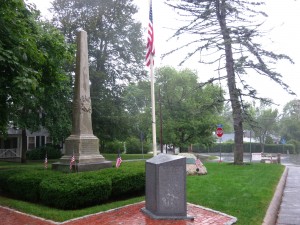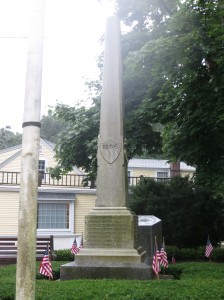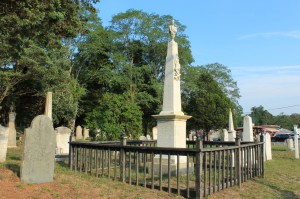 Two English judges who fled a royal death sentence are honored at their hiding place high above New Haven.
Two English judges who fled a royal death sentence are honored at their hiding place high above New Haven.
Judges Cave, at the summit of West Rock State Park, is a large rock formation that, to be fair, stretches the common idea of what a cave looks like.
New Haven’s quasi-cave was the hiding place of Edward Whalley and William Goffe, who were among 59 members of Parliament who signed the warrant condemning King Charles I to death in 1649.
That probably seemed like a good idea until the monarchy was restored in 1660 and Charles II ordered the execution of the judges who had had his father beheaded.
The west face of the rock formation bears a marker reading, “Here May Fifteenth 1661 and for some weeks thereafter Edward Whalley and his son-in-law William Goffe, members of the Parliament General, officers in the army of the Commonwealth and signers of the death warrant of King Charles First, found shelter and concealment from the officers of the Crown after the Restoration. ‘Opposition to tyrants is obedience to God.'”
 The marker on the west face is a replacement for a bronze plaque on the east face that was dedicated in 1896 and later stolen. (The original plaque can be seen in the black-and-white image, which was taken in 1900).
The marker on the west face is a replacement for a bronze plaque on the east face that was dedicated in 1896 and later stolen. (The original plaque can be seen in the black-and-white image, which was taken in 1900).
After fleeing England, Whalley and Goffe stayed briefly in Massachusetts before learning that agents of the Crown were looking for them. In New Haven, they were sheltered by Rev. John Davenport (the city would name streets after all three gentlemen) before hiding atop West Rock.
Their stay at the rock formation lasted about a month before Whalley and Goffe were chased from the cave by a panther. They moved again and resettled in Hadley, Mass.
 The site today can be reached by car, or hikers can find it along the Regicides Trail (the excellent Connecticut Museum Quest site offers a good description of a Judges Cave hike). An overlook area a short drive from the cave provides nice views of downtown New Haven and the harbor.
The site today can be reached by car, or hikers can find it along the Regicides Trail (the excellent Connecticut Museum Quest site offers a good description of a Judges Cave hike). An overlook area a short drive from the cave provides nice views of downtown New Haven and the harbor.
Tags: New Haven
 Bridgeport honors aviation pioneer Gustave Whitehead with a memorial fountain in the city’s west end.
Bridgeport honors aviation pioneer Gustave Whitehead with a memorial fountain in the city’s west end.
The fountain was dedicated in May 2012 to honor Whitehead, who reportedly flew an early airplane in 1901 not far from the fountain’s location at the intersection of Fairfield Avenue and State Street Extension.
The memorial features a replica of Whitehead’s No. 21 flyer above a granite base and four fountains. The fountain’s base proudly proclaims Whitehead to be “First in Flight,” and the plane shifts and its propellers rotate in the wind.
According to articles in the Bridgeport Herald and Scientific American, Whitehead successfully flew in Fairfield, Bridgeport and Stratford in 1901, two years before the Wright Brothers flight in North Carolina.
 Whitehead supporters cite poor record keeping, a lack of photographic evidence, and an agreement between the Wright Brothers’ descendants and the Smithsonian Institution regarding the display of the Wright Flyer at the National Air and Space Museums as reasons Whitehead’s earlier flights aren’t recognized or investigated by aviation historians.
Whitehead supporters cite poor record keeping, a lack of photographic evidence, and an agreement between the Wright Brothers’ descendants and the Smithsonian Institution regarding the display of the Wright Flyer at the National Air and Space Museums as reasons Whitehead’s earlier flights aren’t recognized or investigated by aviation historians.
The fountain was designed by Theodore L. Grabarz, Bridgeport’s deputy director of public works and the designer of the city’s 2009 World War II monument, and the Whitehead plane was designed by Fairfield sculptor Ron Cavalier.
150 years ago, members of four Connecticut regiments, many of them in their first Civil War fighting, were among the 23,000 who lost their lives during the Battle of Antietam. Today, we visit the CTMonuments.net archives to honor the state residents who fought in these Maryland cornfields and helped turn the tide toward reuniting the United States.
Connecticut native and Civil War General Joseph K.F. Mansfield is honored with two monuments near the site of his mortal wounding on the Antietam battlefield.

14th Regiment, Connecticut Volunteer Infantry
A granite obelisk honoring the 14th CT Regiment stands a short distance from the sunken farm road at Antietam that became known as Bloody Lane.
11th Regiment, Connecticut Volunteer Infantry
During the Battle of Antietam, the 11th Regiment was involved in fierce fighting near Burnside Bridge.
8th Regiment, Connecticut Volunteer Infantry
The 8th Regiment has a monument at Antietam on private property along Harpers Ferry Road, just outside the boundaries of the battlefield park.
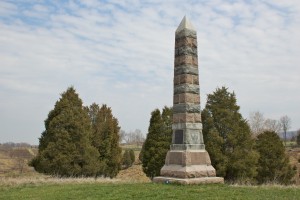 16th Regiment, Connecticut Volunteer Infantry
16th Regiment, Connecticut Volunteer Infantry
The 16th regiment’s service is honored with a multi-colored granite obelisk, dedicated in 1894, on the western edge of the 40-Acre Cornfield off Antietam’s Branch Avenue.
The Antietam National Cemetery is the final resting place of nearly 4,800 Union Civil War veterans as well as more than 200 veterans of other wars.
 One of the oldest Civil War monuments in Massachusetts stands on a small green in the Centerville section of Barnstable.
One of the oldest Civil War monuments in Massachusetts stands on a small green in the Centerville section of Barnstable.
The Soldiers’ Monument in Centerville, a granite obelisk dedicated in July of 1866, stands near the intersection of Main Street and Park Avenue, and is one of several veterans’ memorials on the green.
The Civil War monument’s front (north) face lists eight names of of local residents who died during their Civil War service. The men ranged in age from 19 to 47.
The north face also bears a shield bearing the monument’s 1866 dedication date.
The west face bears seven names of Civil War heroes ranging in age from 17 to 45, as well as a decorative trophy featuring crossed swords and an inscription reading, “They died for their country.”
 The south face bears nine names, ranging in age from 18 to 51, and a shield with an inscription reading, “Erected by the Town of Barnstable.”
The south face bears nine names, ranging in age from 18 to 51, and a shield with an inscription reading, “Erected by the Town of Barnstable.”
The east face lists eight names, ranging from age 16 to 27.
To the north of the Civil War monument, Centerville’s two dozen World War I veterans are honored with a bronze plaque on a boulder that was dedicated in 1927.
Near the southern end of the green, contemporary monuments honor Centerville’s veterans of World War II, Korea and Vietnam.
Tags: Massachusetts
 Brewster, Massachusetts, honors its local war veterans and heroes with a collection of monuments on Main Street.
Brewster, Massachusetts, honors its local war veterans and heroes with a collection of monuments on Main Street.
The war memorials stand in front of the town’s Council on Aging, a Victorian building on Main Street (Route 6A) that was built in 1893 as Town Hall.
The westernmost of the monuments (on your left as you face the memorials) honors Brewster’s World War I veterans. The monument features a plaque on its south face reading, “Memorial to those who served in the World War. Presented to the Town of Brewster by the Brewster Grange 1919.”
The monument lists the names of 43 residents who served in the conflict, and highlights three who died during their wartime service. Among the dead is Roland C. Nickerson, a member of the prominent Brewster family whose land provided the basis for Roland C. Nickerson State Park.
 To the right of the World War I monument, a bronze plaque on a boulder honors Brewster’s World War II veterans. The monument’s dedication reads, “Proudly we pay tribute to the men and women of Brewster who answered their country’s call in World War II.”
To the right of the World War I monument, a bronze plaque on a boulder honors Brewster’s World War II veterans. The monument’s dedication reads, “Proudly we pay tribute to the men and women of Brewster who answered their country’s call in World War II.”
The monument also bears the names of about 120 residents, and honors four who died during the war.
Next to the World War II monument, a smaller memorial honors Brewster residents who fought in the Battle of the Bulge.
To the right of the World War II monument, a memorial honors Brewster’s veterans of the Korea and Vietnam wars. The plaque lists 57 veterans.
 At the far right of the memorial collection, a monument honors “veterans from Brewster who served in foreign campaigns.” The memorial doesn’t list any names, but will likely do so in the future.
At the far right of the memorial collection, a monument honors “veterans from Brewster who served in foreign campaigns.” The memorial doesn’t list any names, but will likely do so in the future.
Tags: Massachusetts
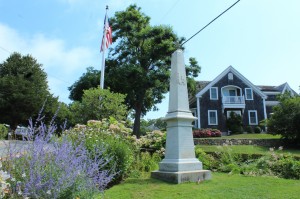 Chatham, Massachusetts, honors its Civil War heroes with a marble monument on a Main Street green.
Chatham, Massachusetts, honors its Civil War heroes with a marble monument on a Main Street green.
The marble obelisk, on a green near the triangular intersection of Main and Seaview streets, bears a dedication on its southwest face reading, “Erected by the town of Chatham in memory of those that fell in the Rebellion of 1861 to 1865.”
The southwest face also bears a decorative trophy depicting crossed rifles and flags.
The southeast face lists the name, affiliation, ages and details about the wounding and death of six local veterans who perished during their Civil War service. The men ranged in age from 19 to 36, and the listing for Benjamin F. Bassett appears to have a correction for his age (an uncommon occurrence for a marble war monument).
 The northwest face lists seven names of war heroes who ranged in age from 18 to 56.
The northwest face lists seven names of war heroes who ranged in age from 18 to 56.
The monument has been attributed to sculptor James H. Jenks.
The monument is not dated, but its similarity to other monuments from the late 1860s (including the 1865 Soldiers and Sailors Monument in Wellfleet) would suggest the Chatham monument was dedicated during that general period.
Tags: Massachusetts
 Wellfleet, Massachusetts, honors its Civil War veterans with a marble monument in the historic Duck Creek Cemetery.
Wellfleet, Massachusetts, honors its Civil War veterans with a marble monument in the historic Duck Creek Cemetery.
The Civil War monument was dedicated in 1866 to honor the 221 residents who served in the conflict.
A dedication on the monument’s west face reads, “Erected to the memory of Wellfleet’s heroes by the Ladies Soldiers Aid Society, assisted by the subscribers to the war fund.”
The west face also features a decorative trophy displaying crossed cannons and muskets, the U.S. shield and a flag.
 The monument’s south face bears an inscription reading, “Bright hopes on freedom’s altar laid,” and honors three residents who died during their service by listing their names, ages, regimental affiliations, and dates and places of death.
The monument’s south face bears an inscription reading, “Bright hopes on freedom’s altar laid,” and honors three residents who died during their service by listing their names, ages, regimental affiliations, and dates and places of death.
The north face bears an inscription reading, “Died for our country in naval service,” and lists details about five residents who died during their service.
Among the five are John D. Langly, 49, who died while serving in New Orleans in July of 1862. His death came shortly after the death of his son, John N. Langly, 22, who died at Cairo, Illinois in May of 1862. The younger John Langly was the third of 10 children the older John Langly would have with Hannah A Baker.
 The monument is topped with a decorative funereal urn topped with a representation of an eternal flame.
The monument is topped with a decorative funereal urn topped with a representation of an eternal flame.
Tags: Massachusetts
 The 1910 Minuteman monument by sculptor Harry Daniel Webster is one of several Westport monuments to a British raid in April of 1777.
The 1910 Minuteman monument by sculptor Harry Daniel Webster is one of several Westport monuments to a British raid in April of 1777.
 The Yalesville section of Wallingford honors a World War II hero and its World War I veterans with memorials on the village green.
The Yalesville section of Wallingford honors a World War II hero and its World War I veterans with memorials on the village green.
Budleski Memorial Park, at the intersection of Main (CT Route 150) and Chapel streets, was dedicated on May 28, 1944, to honor a local airplane mechanic killed over Germany in 1943.
A plaque at the western end of the green reads, “Budleski Memorial Park. In honor of Stanley P. Budleski, 1st Lt. AAF (Army Air Force), who died in action December 20, 1943. Erected by Yalesville Mens Club, November 11th, 1949.
According to the Connecticut Historical Society, Lt. Budleski enlisted in 1942, and was reported missing in 1943. His death was confirmed the following year.
 One of two children of Polish immigrants, Lt. Budleski grew up on his family’s farm a short distance west of the green on Main Street.
One of two children of Polish immigrants, Lt. Budleski grew up on his family’s farm a short distance west of the green on Main Street.
He was honored with a parade on the day the green was named in his memory.
A few steps west of the Lt. Budleski marker, a monument honors Yalesville’s World War I veterans.
The monument bears a dedication reading, “In recognition of those who served in the World War, 1914-1919, from the Village of Yalesville.”
The monument, dedicated in 1939 by the Yalesville Mens Club, lists the names of 27 local World War I veterans.
Tags: Wallingford
 On Sunday afternoon, the 1887 Soldiers’ and Sailors’ Monument in New Haven’s East Rock Park was rededicated in a ceremony that took place on the monument’s 125th anniversary.
On Sunday afternoon, the 1887 Soldiers’ and Sailors’ Monument in New Haven’s East Rock Park was rededicated in a ceremony that took place on the monument’s 125th anniversary.
The rededication was organized by the Connecticut 9th Irish Regiment, the Irish History Round Table and the Connecticut Irish American Historical Society.
An honor guard from several reenactment organizations laid a wreath at the monument’s base, and State Troubadour Emeritus Tom Callinan entertained the crowd with Civil War songs.
The Soldiers’ and Sailors’ Monument was dedicated in 1887 to honor soldiers and sailors who fought in the American Revolution, the War of 1812, the Mexican-American War and the Civil War.
 An estimated 100,000 people attended the monument’s original dedication. Although Sunday’s crowd was a little smaller, the event provided a fitting tribute to the monument and the New Haven veterans it honors.
An estimated 100,000 people attended the monument’s original dedication. Although Sunday’s crowd was a little smaller, the event provided a fitting tribute to the monument and the New Haven veterans it honors.
Tags: New Haven

